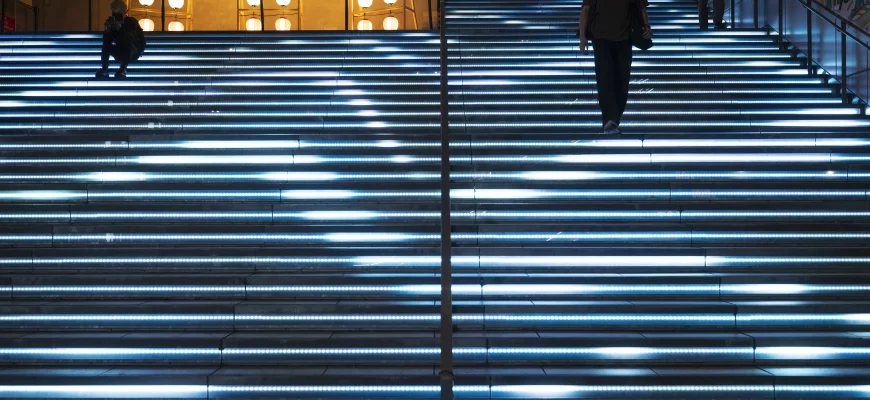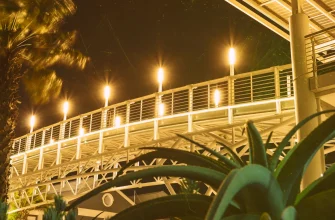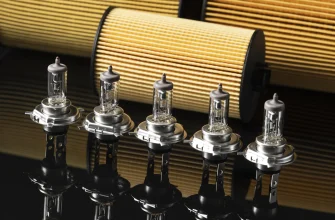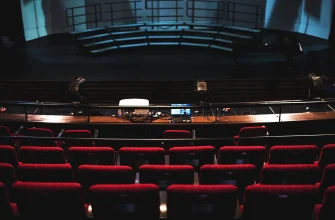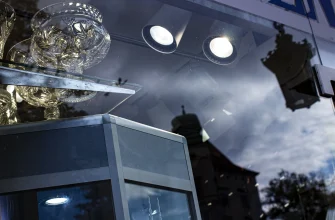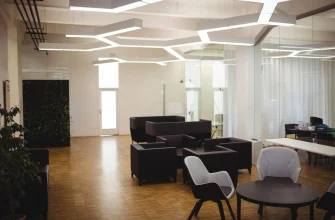Architectural lighting is an important and integral element of lighting design. Illumination of building facades, bridges, fountains and city monuments plays a special role in shaping the nighttime image of the city, creating a unique atmosphere and emphasizing architectural features.
The main purpose of architectural lighting is to create a decorative and aesthetic appearance of buildings. In many cases, lighting is used to draw attention to certain structures, such as the facades of institutions, shops, country houses or cottages. Such lighting makes them more expressive and welcoming, contributing to the formation of a positive image.
How architectural lighting is designed
The architectural lighting design process involves several stages. First, it is necessary to conduct a general assessment of the object, determine its location and functional purpose. In addition, the features of the environment and the impact of the environment are taken into account.
After that, you should make a list of requirements for project equipment and highlight the elements of the building that need to be illuminated. It is important to understand that each object has its own unique characteristics, so the approach to design is always individual. It is necessary to take into account technical requirements and select lighting equipment in accordance with specific conditions. This allows you to achieve a harmonious combination of lighting with the overall architectural style.
Possibilities of outdoor lighting equipment
With the help of well-chosen lighting equipment, you can highlight the entire object or only its individual parts against the general background. Lighting equipment must be functional and reliable. It should also be resistant to adverse weather conditions and have a long service life.
Architectural lighting offers a number of advantages, including:
- Highlighting the necessary elements of the building;
- Attractive, bright and noticeable appearance of the object;
- Effective drawing of attention to the object.
The possibilities for exterior lighting of buildings today are truly endless. With the help of different types of lighting equipment, you can create bright illumination of individual details or fill the object with diffused light. This allows you to “play” with the color balance, creating attractive visual effects that add individuality to buildings.
Technical requirements for architectural lighting
Despite the limitless possibilities of modern lighting equipment, the laws of physics continue to play an important role and cannot be ignored. It is not always possible to place floodlights at the optimal distance from an object. Various technical aspects can affect the final result. For example, special anti-glare technologies are used to reduce glare.
The ideal option for the location of lighting equipment is hidden lighting, when the lighting equipment is placed behind the decorative elements of the building. This allows you to preserve the aesthetic appearance of the object, while providing the necessary lighting effect.
The main techniques used to create architectural lighting are:
- Built-in luminaires;
- Spotlights;
- Mini spotlights and bus systems;
- Lanterns.
Lighting equipment for outdoor lighting can work on the basis of various technologies: LED, halogen, xenon, fluorescent and gas discharge lamps. The choice of equipment depends on the characteristics of the object and the desired effect.
When designing architectural lighting, it is very important to strike a balance between aesthetics and functionality. The lighting should not contradict the overall style of the building, but at the same time, it should successfully highlight the necessary elements and accents.
In addition, it should be borne in mind that the same lighting solution can be perceived differently by observers depending on the background brightness, location of light sources, their power, and other technical characteristics.
Tips for designing architectural lighting
When designing an architectural lighting project, the most important task is to choose the right equipment for each specific case. Only by taking into account all the nuances of the object and the specifics of its use can the desired result be achieved.
A combination of white and colored light is often used to create lighting ensembles. The use of different light sources, such as metal halide lamps and LED lights, allows you to create impressive, bright compositions, adjust the color level and saturation, and control the power of light fluxes.
Depending on the architectural design, you can choose the following types of lighting:
- Flood lighting of the building. It is carried out using high-power luminaires that are placed on special supports or nearby buildings. This type of lighting is used to create light spots of the desired size and is often used in country houses and cottages.
- Local lighting. It is used to highlight individual building elements, such as columns, cornices, sculptures, against the general background.
- Concealed lighting. It is used to illuminate objects such as stairs, fountains, bridges. Lighting equipment is mounted in such a way as to remain invisible to the observer.
- Decorative illumination. This is a group of lighting equipment designed to decorate objects. It creates effects such as moving lights, light figures, garlands, etc.
- Light graphics. It is used to create contrasting patterns on the facade of a building with the help of special luminaires that have a system of lenses and reflectors. Duralight can also be used – a transparent wire with small LED lamps inside.
Only a professional approach to design, including an expert choice of equipment, creativity in design and attention to detail, as well as the right selection of lighting equipment, can provide a truly impressive result. Every aspect, from the choice of technology to proper installation, affects the overall impression left by the illuminated object.
Teamwork is the key to success
The successful creation of architectural lighting is possible only through the professional teamwork of engineers and designers. Each specialist contributes to the creation of the project, which allows us to realize the most complex ideas and make lighting a part of art.
Thus, architectural lighting not only improves the appearance of buildings, but also creates an atmosphere that adds aesthetic value to our living environment. Proper use of light makes it possible to make each object unique, emphasize its features and give viewers an unforgettable experience.
